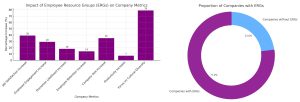Welcome to our ultimate guide on diversity jobs. You’ve come to the right place, whether you’re just entering the job market or seeking a more inclusive workplace. The importance of diversity, equity, and inclusion (DEI) in the workplace cannot be overstated. Diverse work environments foster innovation and creativity, enhance employee satisfaction, and contribute to societal growth.
This guide is designed to navigate the landscape of diversity jobs, emphasizing why they matter, how to find them, and their benefits for individuals and organizations. Through actionable advice and insights, we aim to empower job seekers and employers to champion DEI in their careers and businesses. So, let’s embark on this journey to understand the vast world of diversity jobs and how embracing inclusivity can pave the way for a brighter, more inclusive future.
Understanding Diversity Jobs
Diversity jobs go beyond just a label. They represent a shift towards inclusive and equitable workplaces. Such positions focus on bringing together a mix of talents, backgrounds, and perspectives. These jobs are spread across all industries, from automotive gigs to education jobs and executive levels.
Perceptions and Importance of DEI in the Workplace
Let’s examine the differences in how various demographic groups perceive DEI efforts in their workplaces. Interestingly, most workers see the focus on increasing diversity, equity, and inclusion as positive but place varying degrees of importance on working in a diverse environment based on gender, race, age, and sexual orientation. Diversity Jobs is more than just a phrase; it’s becoming a national focus. Here’s a summary based on various sources:
Perceptions of DEI
- Gender Differences: Women (17%) are likelier than men (12%) to feel their employer pays too little attention to DEI, while men are likelier to overthink and attention is paid to it.
- Racial Differences: Black workers (28%) are most likely to say their company pays too little attention to DEI, compared to White (11%), Hispanic (19%), and Asian (17%) workers.
- Political Differences: Democrats are more likely than Republicans to say their employer pays too little attention to DEI, and vice versa for paying too much attention.

Importance of DEI
- Job Satisfaction and Employer Attractiveness: The Great Resignation highlighted that employees value DEI, pay, and work/life balance when choosing an employer. A significant portion of Gen Zs and Millennials are not satisfied with their current organization’s DEI progress. Nearly half of Gen Zs (46%) and four in 10 millennials (39%) say they feel stressed or anxious at work all or most of the time.
- Trust and Engagement: Trust in an organization’s DEI commitments enhances employee engagement and performance. A lack of confidence could lead to reduced engagement and an increased likelihood of employees leaving the organization. More than 6 in 10 Gen Zs (61%) and around half of millennials (49%) have experienced harassment or microaggressions at work in the past 12 months. Inappropriate emails, physical advances, and physical contact are the most common types of harassment, while exclusion, gender-based undermining, and unwanted jokes are the most common types of microaggressions.
- Of those who experienced harassment, around eight in 10 reported it to their employer. However, a third of Gen Zs and a quarter of millennials don’t think the issues were handled effectively. Women, non-binary, and LGBT+ respondents are less likely to report harassment to their employer and less likely to feel their organization responded well.
- Innovation and Problem-Solving: Exposure to diverse perspectives in a DEI-focused culture can improve innovation, problem-solving, and business ethics.
Benefits of DEI
- Enhanced Innovation: Diverse and inclusive teams create an environment where people can be themselves without judgment. They’re more likely to take risks and share new ideas when that happens. They won’t accept “we’ve always done it this way,” which is essential to doing things differently and unlocking innovation.
- Improved Decision-Making: Inclusive organizations with diverse viewpoints have better decision-making processes. Diversity ensures decisions are inclusive and considerate of different experiences and needs.
- Increased Employee Engagement: Employees are more engaged when their unique contributions are recognized in an inclusive workplace. An inclusive culture cultivates a sense of belonging, respect, and psychological safety, which increases employee engagement and productivity. Employees are more likely to feel valued for their unique contributions when celebrated and recognized.
- Attracting Top Talent: Companies with vital DEI initiatives are more attractive to job seekers and can retain top talent. Prospective employees are not only watching who you hire but how you treat them once they are employees. Diversity jobs are more innovative and have better business outcomes than their less diverse counterparts. Inclusive, creative, successful businesses will always attract top job candidates.
- Business Performance: Diverse teams outperform homogeneous ones, leading to better company performance and profits. Diverse teams are over 35% more productive. Companies focusing on diversity jobs earn 2.5x higher cash flow per employee. McKinsey research found that companies in the top 25% for ethnic and cultural diversity were 36% more profitable than those in the bottom quarter. Diverse teams can be 70% more likely to capture and penetrate new markets.
Creating an Inclusive Work Culture
- Leadership Commitment to Diversity Jobs: Developing an effective EEO Policy is crucial. Leaders must advocate for DEI and demonstrate commitment through active listening, empathy, and open-mindedness. Leaders must treat all employees fairly and respectfully and can actively engage with diverse perspectives and experiences. Additionally, leaders should set clear goals and expectations and hold other leaders accountable for their DEI commitments.
- Unconscious Bias Training: Raising awareness of biases can lead to more equitable practices. Many companies have turned to unconscious bias training to become more diverse, equitable, and inclusive. By raising awareness of the mental shortcuts that lead to snap judgments—often based on race and gender—about people’s talents or character, it strives to make hiring and promotion fairer and improve interactions with customers and colleagues. However, research shows that most unconscious bias training is ineffective. The problem is that increasing awareness is not enough—and can even backfire—because sending the message that bias is involuntary and widespread may make it seem unavoidable. Unconscious Bias training that gets results, in contrast, teaches attendees to manage their biases, practice new behaviors, and track their progress. It gives them information that contradicts stereotypes and allows them to connect with colleagues whose experiences differ from theirs. And it’s not a one-time session; it entails a longer journey and structural organizational changes.
- Diverse Hiring Practices: Ensuring inclusivity in recruitment processes broadens candidate access. Using gender-neutral language and explicitly stating your commitment to diversity and inclusion can attract more applicants. Committing to inclusive hiring means that your company will be composed of people from different backgrounds and identity groups, just like the customers and communities you serve. When your company accurately reflects the world around you, you are more likely to build better, more inclusive products.
Maintaining an Inclusive Work Culture
- Employee Resource Groups (ERGs): ERGs provide safe spaces for underrepresented groups, allowing them to speak out, process experiences, and connect with others. ERGs can provide valuable feedback and insights to management and executive teams. This feedback can help organizations make informed decisions about DEI initiatives. Furthermore, they can advocate for underrepresented demographics in the workforce. This can lead to more inclusive company policies and a positive work environment. ERGs can help boost feelings of inclusion for underrepresented workers, attract new talent, and improve the retention of employees who identify with underrepresented segments.
- Regular Assessments: Measuring DEI progress helps identify areas for improvement. Consistent evaluation of progress toward the organization’s DEI goals and metrics is crucial for maintaining momentum and identifying areas for improvement. This can involve setting regular milestones or checkpoints to review the data and assess the effectiveness of the implemented initiatives. Highlight what you’re already doing well. Identify your key barriers to making progress. Point to the most impactful next steps. Inform your DEI strategy and decision-making to help you better allocate resources and budget to solve critical challenges.

Challenges
- Building Equity: Organizations must work actively to create equitable environments for diverse workforces, which involves addressing systemic inequities and biases. Check out our article on Common Mistakes that might undermine diversity jobs programs.
- Maintaining Diversity and Inclusion: Without inclusion, diversity efforts can fail, as employees may leave if they don’t feel a sense of belonging or authenticity in the organization’s DEI efforts.
Political Influence on Diversity Jobs
In recent years, notable social movements such as Black Lives Matter, #MeToo Movement, Indigenous Rights Movements, LGBTQ+ Rights Movements, Immigrant Rights Movements, and Disability Rights Movements have significantly heightened the focus on diversity and inclusion within Corporate America. This shift reflects a broader societal acknowledgment of systemic racial inequalities, spurring many companies to prioritize diversity in their organizational structures and practices.
Discrepancy in Corporate Leadership Representation
Despite the increased emphasis on diversity, disparities in representation continue to persist, particularly in the corporate executive landscape. For instance, while Black individuals constitute 13.4% of the U.S. population, their representation at the highest corporate levels remains disproportionately low. Notably, only about 2% of corporate executives are Black. This discrepancy highlights a significant gap between societal demographics and corporate leadership representation.
Various factors, including political and social dynamics, impact efforts to enhance the diversity of jobs in businesses. The advocacy and visibility brought about by social movements have undoubtedly played a role in shaping corporate policies and practices. However, translating these policies into tangible changes in workforce composition, particularly at the executive level, presents ongoing challenges.
Complexities of Hiring and Racial Inequality
The issue of racial inequality in the hiring process is multifaceted. It encompasses the recruitment and selection procedures and the retention and advancement opportunities within organizations. Factors contributing to this inequality include unconscious biases, lack of access to mentorship and networks, and systemic barriers that have historically limited opportunities for underrepresented groups.
Achieving Corporate Diversity
The progress in addressing these disparities has been incremental, and the path toward achieving equitable representation in corporate leadership is complex. It requires a sustained commitment to recruiting a diverse workforce and fostering an inclusive environment where all employees have equal opportunities to be heard, advance, and succeed.
While social movements have been instrumental in bringing diversity jobs issues to the forefront of corporate agendas, the journey towards achieving racial equality, particularly in leadership roles, is ongoing. It necessitates a holistic approach that addresses systemic barriers and promotes inclusive practices at all levels of corporate operations.
Diversity Jobs in Corporate America
In Corporate America, this is a pressing issue. In Corporate America, the challenge of underrepresentation extends beyond just women of color to include various minority groups, each facing unique barriers to achieving leadership roles.
Women of Color
For women of color, their presence in leadership positions is notably low. Despite making significant strides at entry-level roles, they hold only 5% of C-suite positions, indicating a substantial drop in representation as they move up the corporate ladder.
Black Employees
The situation for Black employees, in particular, is striking. While they comprise 14% of all U.S. employees, their representation at the managerial level falls to just 7%, and it declines further at senior-manager levels, such as vice president and senior vice president, to 5% and 4%, respectively. This underrepresentation is compounded by challenges such as less manager support and fewer interactions with senior leaders, impacting their career advancement.
Latinos in Leadership
Latino representation in leadership also reflects a significant disparity. Latinos comprise 18% of the U.S. population but hold just 5.3% of executive positions. Factors contributing to this underrepresentation include increased scrutiny of qualifications, a lack of role models and mentors, and cultural barriers in the workplace.
More to be Done
In terms of board diversity, the latest data reveals that more than half of the Fortune 500 boards have 40% of their seats held by White women and individuals from underrepresented racial and ethnic groups. However, minority men have not seen a substantive increase in their representation rate. The power and utilities sector has the highest percentage of African American/Black directors; the technology sector leads in Asian/Pacific Islander directors, and the energy and chemicals sector has the highest representation of Hispanic/Latino(a) board members.
These statistics highlight the persistent challenges in achieving equitable representation in corporate leadership. They underscore the need for targeted efforts to promote inclusivity and diversity at entry levels and senior leadership roles. Addressing these disparities is crucial for creating a corporate environment that values the talents and insights of all individuals, fostering innovation, and better reflecting a diverse customer base.

FAQs on Diversity Jobs
Finding and securing diversity jobs raises many questions. Here are some common inquiries with straightforward answers to help you navigate the search for inclusive employment opportunities.
What are diversity jobs?
Diversity jobs refer to positions in companies actively seeking to foster a diverse and inclusive workplace. They value varied backgrounds, experiences, and perspectives.
Why are diversity jobs important?
They create more innovative, equitable, and thriving workplaces. Diversity jobs help companies better understand and serve their diverse customer base.
How can I find diversity jobs?
Start by researching companies with firm DEI commitments. Look for diversity career fairs and job boards focused on inclusive employment.
What can I do to stand out when applying for diversity jobs?
Highlight your unique experiences and perspectives. Also, demonstrate your commitment to fostering an inclusive environment in your application.
Can diversity jobs be found in all industries?
Yes, companies across all sectors are increasing their DEI efforts from tech to healthcare, education to executive roles.
Are diversity jobs only for certain groups?
No, diversity jobs aim to create inclusive workplaces for everyone, including all races, genders, ages, and abilities.
Remember, securing diversity jobs goes beyond just landing a position. It’s about contributing to a workplace where everyone feels valued and included. Your unique perspective can help shape a more inclusive future for all.
Conclusion
As we look towards the future, it is clear that diversity, equity, and inclusion are vital parts of a successful and sustainable workplace. The trends and statistics of diversity jobs reflect progress and enduring challenges in achieving genuine diversity and inclusion jobs. While efforts to improve diversity jobs are increasingly recognized as essential, the discrepancies in leadership representation and the experiences of underrepresented groups show that much work still needs to be done.
The journey towards a more equitable corporate landscape is ongoing and requires continuous commitment and innovation. Organizations must advocate for diverse jobs and actively work to dismantle systemic barriers and foster an environment where everyone can thrive. As we move forward, it will be imperative for companies to not only embrace DEI in policy but to embed it deeply into their culture, practices, and leadership. Only then can we hope to see a corporate world that reflects our society’s diverse jobs and harnesses its people’s full potential.
Now is the time to join the movement towards a more diverse and inclusive workplace. Join Diversity Employment today and take the first step towards empowering yourself and contributing to a world where everyone has the opportunity to succeed. Let’s work together to champion diversity and inclusion, making it not just a goal but a reality in workplaces around the globe.




